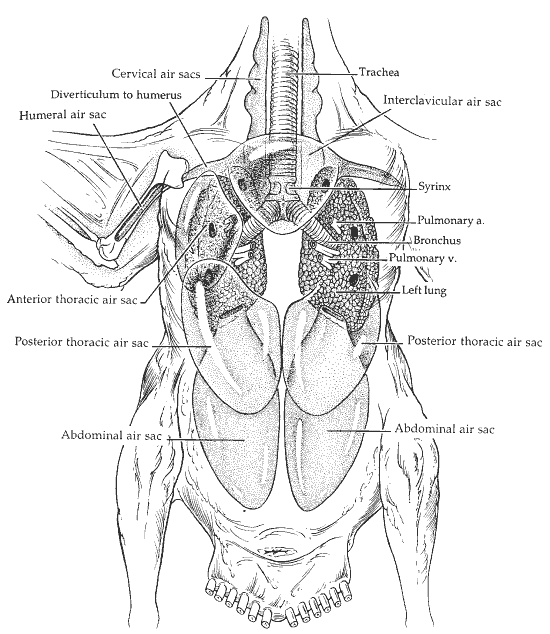Mammals and reptiles have 2-way air flow; air passes in and out of the lungs, traveling the same pathway. Birds have a 1-way air flow system, causing air to be filtered twice in a system that does not have the lung capacilty which ours has. Air continuously passes over the bird's lungs and therefore, continuously picks up any and all things in the air they breathe. The air sacs, which you see in the diagram, deliver air throughout the respiratory system, so eventually, any pollutants which enter the bird's body will enter the air sacs and will be delivered as far as the tip of the wing and into the bird's thigh, as well as being passed over the lungs.
Let's look at the diagram of an avian wing below to see how far the air sacs extend.....
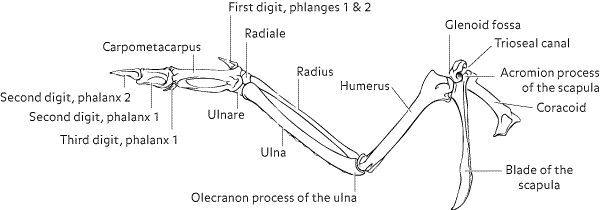
See the hollow spaces between the wing bones? These hollow spaces contain air sacs, which must fill in order for the bird to sustain flight. They also will fill with whatever happens to be present in the air.
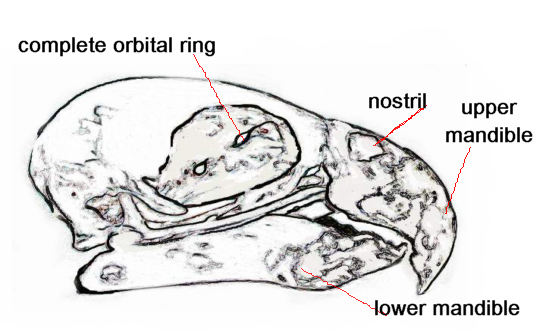
The skull to the left is not a Quaker skull, but will serve our purpose, which is to talk about sight and sense of smell. For most birds, sight is the most important sense. The avian optic lobe of the brain is larger and better developed than that of mammals. The size of the avian eye in relation to the size of the head is also greater than in mammals. The eyes of birds of prey, such as owls, and those who forage for food nocturnally, will be positioned and shaped differently than our Quaker's, who are non hunters. Quaker eyes are positioned at the sides of their head. Their vision is called monocular vision; meaning they are capable of seeing from the side and front. This extends their field of vision more than that of birds of prey. Birds focus faster and better than humans can because their corneas are softer than those in humans, allowing what is called "accomodation"; the ability to focus on an object. Focussing occurs when the lens of the eye, and/or cornea, changes shape. The softer the cornea, the quicker the focus.
Most birds are capable of seeing 3-4 colors, so when your Quaker sets off the Quaker Alarm when you are dressed in your best red shirt, don't be surprised! Birds also have a third, clear eyelid! The purpose is to spread tears over the cornea so that it doesn't dry out during flight.
Sense of smell is not as developed in passerines, ( those smaller birds, such as wrens, chickadees, larks and swallows), and parrots, as it is in some birds, such pigeons and ocean birds. Above, we learned that the parrot optic lobe in the brain is large. In comparision, olfactory lobes, or ears, are small in parrots because they are of lesser importance.
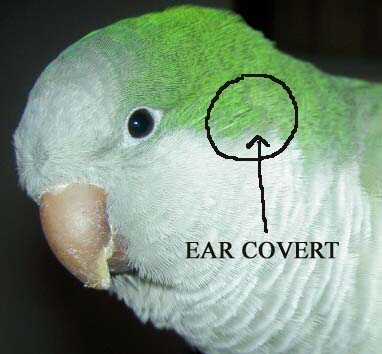
Quaker's "ears" are fascinating because the openings are covered by specialized feathers. The feathers minimize air turbulence in flight. The visible part of the ear, as we know it, is lacking, but internally, their ears have 3 chambers, very similar to ours. Inside a Quaker's ear, the semicircular canals and the utricle are concerned with balance.
Birds hear very well, but differently than we do. Birds hear in absolute pitch, while we generally hear in relative pitch. To simplify absolute and relative pitch, absolute pitch is pure and not a guess, determined by computing the number of vibrations per second. Relative pitch is a comparison and not absolute. In birds, an absolute pitch becomes embedded in memory. At the same time, let's say we hear a song in one octave. Relative pitch allows we humans to hear that same song in another octave and recognize it. Birds cannot do this. This may be why, when we are teaching our Quakers to "talk", it is important to pronounce a word or phrase in the same tone, over and over.
photo courtesy of Fonzie and Ellen Krueger
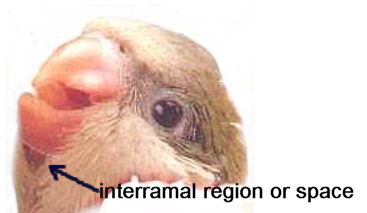
Have you flipped your Quaker over today? If you haven't, today is a good day to start. Being able to flip your Quaker so that it lies comfortably on its back in your hand is a great way to examine your bird in cases of emergency, or for vet visits.
The best way to begin is to give your Quaker a good soaking bath and then wrap it in a nice comfy towel and cuddle. After you have been practicing for some time and everyone looks forward to the cuddle session, you can try to flip your Quaker over without the towel, by gently placing your fingers across his or her back, with your thumb resting across, not pushing, on the bird's abdomen. Just rotate your wrist, and presto! A bird in the hand is worth....never mind!
Right now, what we want to look at is the interramal region in the picture to the left. People who have never viewed the interramal region, and see it for the first time, sometimes panic and want to know what that big, fleshy looking hole is under their Quaker's beak! There's nothing wrong with your bird! This is the area that cradles the tongue, and this brings us to discussing your Quaker's sense of taste and other things about the Quaker tongue.
Have you ever given your Quaker a hot pepper and watched it devour it with glee? Birds have fewer taste buds than humans. Humans have approximately 9000 taste buds on their tongue, while birds have approximately 300-400.
Birds also have a bone in their tongue. The avian tongue is also muscular. A bird's mouth cavity does not have a continual saliva or water flow as a mammal's mouth cavity does. The avian tongue has various elevated places called papillae. The muscular tongue and the papillae serve to manipulate food and objects your bird may put in its mouth. Has your Quaker ever put something in its mouth that you tried to take from them? While you are busy trying to remove the object, their strong and dexterous tongue is just as busy moving and hiding that object around its mouth, out of view and away from your fingers. |

